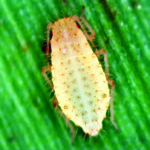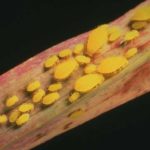Many insect pests of grain sorghum also feed on forage sorghums, sorghum-sudan hybrids, and millets harvested as hay, forage, or silage. However, not all insecticides labeled for grain sorghum are also labeled for forage sorghum. Read the label to determine if the insecticide can be used on sorghums and millet grown for hay, fodder, or silage.
Chinch bug
Chinch bugs suck plant sap and cause sorghum leaves to turn red and die. Infested plants wilt, their growth is stunted, and the seedlings may die. Sorghum is most susceptible to injury during the seedling stage until the plants are about 18 inches tall. Chinch bugs are common during hot, dry weather.
Adult chinch bugs are black with whitish wings that lie flat across the back. Immature chinch bugs are red with a white band across the back.
Both stages feed on the plant stem just at and below the soil line and behind the leaf sheath of lower leaves. They run when disturbed.
Chinch bugs can move into sorghum fields from nearby wheat fields or from wild bunch grasses.
Management
Scout sorghum for chinch bugs during the seedling stage until plants are about 18 inches tall. Look for chinch bugs around the base of the plant just at or below the soil line. Also, pull back the lower leaf sheaths to look for chinch bugs. Examine plants in at least five places in the field.
Apply an insecticide (Table 5) when you find two or more adult chinch bugs on 20 percent of the plants when seedlings are less than 6 inches tall. On taller plants, the treatment threshold is when you find immature and adult chinch bugs on 75 percent of the plants.
Apply the insecticide as a directed spray toward the base of the plant, where chinch bugs feed. Use sufficient gallons per acre, as directed by the label, to make sure that the lower stem of the plant is covered well.
Sugarcane aphid
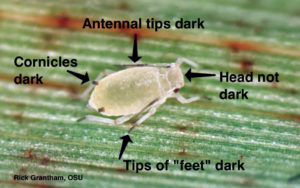
The sugarcane aphid (SCA) has recently become one of the most damaging insect pests of grain and forage sorghums in Texas and the southern United States. The aphid is pale yellow, gray, or tan (Fig. 38). The antennae, feet, and “tailpipes” (cornicles) are black.
All SCA are females and give birth to live young, which mature into adults in about 5 days. Aphid numbers can increase quickly in the summer.
The SCA feeds by sucking plant sap from the underside of sorghum leaves. Although colonies initially consist of only a few aphids, they can increase quickly to cover much of the lower leaf surface. They feed on grain and forage sorghums (Sudan grass, sorghum/Sudan hybrids) and Johnsongrass.
The feeding causes the leaves to turn yellow and finally brown as the leaf tissue dies (Fig. 39). Extensive feeding by SCA can reduce grain and forage yields and increase lodging due to stalk rot. The aphids produce large amounts of honeydew—a shiny, sticky waste product composed primarily of water and plant sugars. It eventually dries to a harmless residue.
Honeydew accumulates on the leaves, making them sticky and shiny. When the humidity is high, a black, sooty mold often grows on the honeydew. The mold blocks the light needed for photosynthesis and may reduce the effectiveness of pesticides.
Honeydew on the leaves and stems can also gum up machinery at harvest.
Management
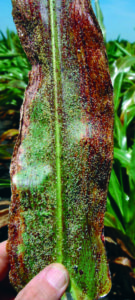
Scout forage sorghums once a week for sugarcane aphids. Crop damage can occur during the pre-boot stage through grain maturation and often can increase rapidly in hot, dry weather. Look for colonies on the underside of leaves. Check also for honeydew, which can indicate a colony on the leaf above.
In grain sorghum, treatment is suggested when the aphids reach 50 per leaf or more during the pre-boot and boot stage.
Treatment thresholds have not been determined for SCA on forage sorghums. Until they become available, use the thresholds for grain sorghum as a guide for making treatment decisions.
To control SCA with foliar-applied insecticides (Table 6), the insecticide spray must cover the entire plant canopy thoroughly, including the lower leaves.
An alternative to insecticide treatment may be grazing or early harvest. If you are planning a second cutting, continue to monitor the infestation weekly because the aphids may reinfest the field.
Yellow sugarcane aphid
The yellow sugarcane aphid is bright lemon yellow and has many long hairs (Fig. 40). Two lines of black dots are usually visible down the back. This aphid feeds on the underside of sorghum leaves but produces little or no honeydew.
While feeding, yellow sugarcane aphids inject a toxic substance into the leaf. The toxin turns the seedling leaves purple and stunts plant growth (Fig. 41). Even a few yellow sugarcane aphids—two or three per leaf—can damage seedling sorghum plants.
Feeding on older plants causes the leaves to turn yellow and die.
Management
Inspect the plants beginning the first week of emergence and twice weekly until the plants have at least five true leaves.
Treatment thresholds for yellow sugarcane aphid in forage sorghum have not been determined. Treatment thresholds for grain sorghum range from about 10 percent of the plants with one or more yellow sugarcane aphids per plant at the one-true-leaf stage, and about 40 percent of the plants with one or more yellow sugarcane aphids per plant at the three-true-leaf stage.
For detailed treatment thresholds for grain sorghum plants with one to three true leaves across a range of control costs and crop market values, see Texas A&M AgriLife publication B-1220, Managing Insect and Mite Pests of Texas Sorghum, which is available from the county Texas A&M AgriLife Extension office or online at http://agrilifelearn.tamu.edu/Managing-Insects-and-Mite-Pests-of-Texas-Sorghum-p/eb-1220.htm. At the threshold, consider applying an insecticide (Table 7).
Chlorpyrifos, zeta-cypermethrin, and beta-cypermethrin do not control the sugarcane aphid, which may increase after
these products are applied because of the loss of beneficial insects. If both sugarcane and yellow sugarcane aphids are present, consider Sivanto Prime or Transform.
Fall Armyworm and corn earworm
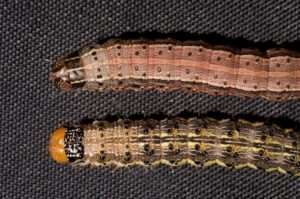
The larvae of fall armyworms and corn earworms (Fig. 42) feed on leaves within the whorl of the sorghum plant. When feeding in sorghum whorls, the larvae are called whorl worms. As the leaves emerge from the whorl, the feeding damage becomes evident as a series of round or ragged holes across the leaf blade.
Fall armyworms are identified by the white, inverted “Y” pattern on the face. Corn earworms have brown heads, lack the Y pattern, and have short spines along the body (Fig. 58).
To confirm that the culprit is fall armyworms or corn earworms (rather than grasshoppers, etc.), pull the whorl from the plant and unroll the leaves. The larvae and their excrement (frass) would be in the tightly rolled leaves.
Although the leaf damage looks dramatic, the forage loss from leaf feeding alone is usually insignificant, and control during the whorl stage is seldom economically justified.
Management
Consider an insecticide treatment (Table 8) if fall armyworms are feeding on the growing point of plants less than 6 inches tall or if infestations threaten to reduce the leaf area by 30 percent or more. Before applying an insecticide, confirm that fall armyworms are still present by locating larvae in the whorl.
Controlling fall armyworms with insecticides is difficult because they are somewhat protected in the tightly rolled whorl leaves. Ground applications using 15 to 20 gallons of water per acre with nozzles directed over the top of the row increase penetration of the insecticide deep within the whorl and improve control.
Chemigation of insecticides, if approved on the label, through center pivot systems can improve the chemical’s effectiveness.
Because fall armyworm populations in- crease as the season progresses, late-planted sorghum is at greater risk of infestation than early-planted sorghum.
Grasshoppers in forage sorghum
For information on grasshopper biology, damage, and management, see page 5.
Insecticides labeled for control of grasshoppers in forage sorghums are shown in Table 9.
